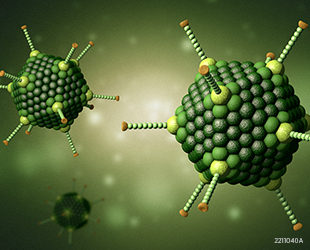Clinical Trial Suggests New Immunotherapy May Treat Viral Infections
A new immunotherapy targets six different viruses that can cause infections when the immune system is suppressed to allow potentially life-saving transplants, according to trial results published in the AACR journal Clinical Cancer Research.

A stem cell transplant can be a lifesaver for people with leukemia, lymphoma, multiple myeloma, or other types of blood cancer or other blood diseases. But potentially life-threatening viral infections frequently occur because the immune system is suppressed to allow the treatment to work.
Now, a therapy called posoleucel is being tested that fights the infections with T cells targeted against six different viruses. In a clinical trial of people who had received stem cell transplants and developed viral infections, 95 percent of the patients receiving posoleucel had a positive response, with an average reduction in the viral load of 97 percent, according to a report published in Clinical Cancer Research, a journal of the American Association for Cancer Research.
“Overall, posoleucel was found to be very effective and had a favorable safety profile in a highly vulnerable patient population,” said Thomas Pfeiffer, MD, an author of the study and an assistant professor of pediatrics at Washington University School of Medicine in St. Louis.
T cells are an important component of the body’s immune system that hunt down and destroy virus-infected cells. Posoleucel is made up of virus-specific T cells obtained from donors and can be kept under controlled conditions until needed.
Since posoleucel utilizes healthy donor T cells rather than the patient’s or transplant donor’s T cells, it avoids the lengthy development process of more customized therapies, making it an off-the-shelf therapy readily available for use, added Bilal Omer, MD, the study’s senior author, a pediatric hematologist-oncologist at Texas Children’s Hospital, and an assistant professor of pediatrics and member of the Dan L Duncan Comprehensive Cancer Center at Baylor College of Medicine
Posoleucel includes donor T cells that target six of the most common viruses seen in patients following stem cell transplants: adenovirus, BK virus, cytomegalovirus (CMV), Epstein-Barr virus, human herpes virus 6, and JC virus.
“Patients with these viral infections often have severe symptoms and require treatment as soon as possible,” Dr. Omer said. “Another exciting observation from this study was that posoleucel could be administered within 24 hours in some cases, with symptom resolution in a matter of days in some patients. It was quite impressive how quickly patients could be treated.”
The trial enrolled 58 adult and pediatric patients who had undergone stem cell transplants to treat cancers or other diseases of the blood and had infections of at least one of the six viruses that posoleucel is designed to target. The patients either did not respond to the antiviral treatments usually given or were unable to tolerate those treatments. In total, there were 70 viral infections in the trial population, the majority of which were CMV and BK virus infections.
“The ability to target six viruses with a single therapy would be beneficial for patients with multiple viral infections,” added Dr. Omer. “Additionally, posoleucel is the first T-cell therapy in development for BK virus, which can cause severe bladder infections, resulting in excruciating pain for patients.”
Patients who receive T-cell therapies sometimes experience a potentially severe reaction called cytokine release syndrome. In this clinical trial, none of the patients experienced that syndrome.
A hazard of using donor cells, like those used in the development of posoleucel, is graft versus host disease (GvHD), in which the immune system reacts negatively to the donor cells. Some 22 percent of patients in the trial reported acute (GvHD). However, only four of these were considered new cases, as nine patients had been diagnosed with GvHD prior to their treatment with posoleucel. The most common GvHD symptoms were skin flares, which were successfully treated in the majority of cases.
Responses were defined as reduction of viral load to normal range with resolution of clinical signs and symptoms (complete response), or as a viral load reduction of at least 50 percent or a 50 percent improvement of clinical signs and symptoms (partial response).